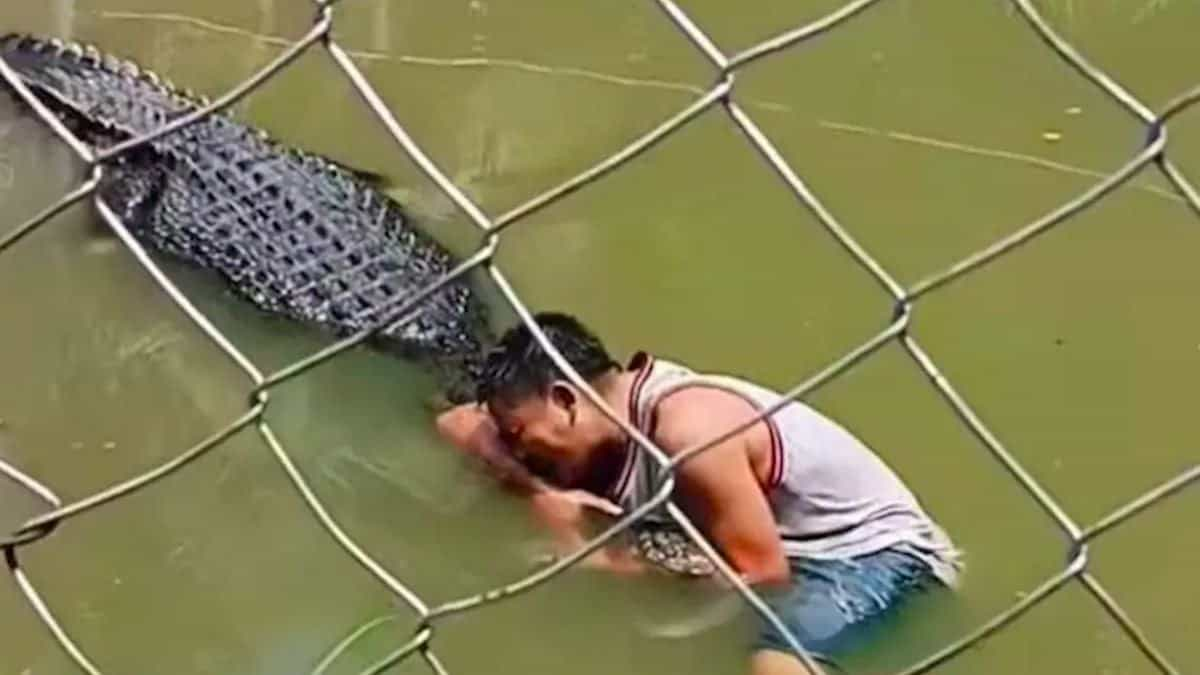Show table of content Hide table of content
In a shocking incident at the Zambonga Sibugay Zoo in the Philippines, a 29-year-old tourist experienced a terrifying encounter with a crocodile after mistaking it for a decorative statue. The alarming event, which occurred on April 28, 2025, serves as a stark reminder of the dangers of wildlife encroachment and the importance of respecting safety barriers at animal facilities.
Dangerous selfie attempt leads to crocodile attack
The tourist’s decision to climb into a crocodile enclosure for what he later described as a photo with a “plastic statue” quickly turned into a nightmare. Video footage captured the moment when the man waded through shallow water toward the motionless reptile, smartphone in hand, seemingly oblivious to the imminent danger.
As the unsuspecting visitor approached the crocodile, the predator suddenly lunged, clamping its powerful jaws around the man’s arm and leg. His screams of agony echoed throughout the zoo as other visitors watched in horror. Despite the excruciating pain, the victim attempted to remain still, instinctively understanding that excessive movement might further provoke the animal.
This incident bears similarities to other dangerous wildlife encounters, including a case where a Florida couple came face-to-face with a 6.5-foot alligator in their dining room. Both situations highlight how quickly reptilian predators can strike when humans enter their territory.
Wildlife experts emphasize that crocodiles, like many predators, can remain perfectly still for extended periods while hunting. This behavior, often misinterpreted by uninformed observers as artificial or decorative, is actually a highly evolved hunting strategy that makes these reptiles such effective ambush predators.
Rescue efforts and medical treatment
The harrowing ordeal lasted approximately thirty minutes before zoo staff could safely intervene. Caretakers of Lalay, the female crocodile involved in the attack, eventually managed to loosen the reptile’s grip by striking its head with a concrete block. This dangerous rescue operation required precision to avoid further injuring the victim while also preventing harm to the animal.
Following his extraction from the enclosure, emergency responders immediately transported the tourist to a nearby hospital. Medical staff treated his severe lacerations, ultimately requiring over 50 stitches to close his wounds. Despite the severity of the attack, the victim survived what could have easily been a fatal encounter.
Animals A female sea lion refuses to mate with a male, causing a fight and the closure of the zoo.
The incident calls to mind other dangerous wildlife encounters, such as when a woman was attacked by a 23-foot python while picking vegetables in her garden. Both cases demonstrate the potentially deadly consequences of unexpected animal encounters.
According to preliminary investigation reports, the tourist claimed he believed the crocodile was merely a plastic statue, an explanation that has generated significant skepticism given the zoo setting and presence of clear enclosure boundaries.
Safety regulations at wildlife facilities
This alarming incident has reignited discussions about visitor safety protocols at zoos and wildlife sanctuaries. Most facilities worldwide implement multiple safety measures, including physical barriers, warning signs, and surveillance systems, specifically designed to prevent such dangerous interactions.
Zoo management stated that clearly visible warning signs were posted throughout the facility, explicitly prohibiting visitors from entering animal enclosures under any circumstances. Additionally, the crocodile exhibit featured standard safety barriers that the tourist deliberately circumvented to access the enclosure.
Animals A hammerhead shark crashes down from the sky in South Carolina, halting a disc golf game.
Wildlife experts note that even seemingly docile animals can become unpredictable when stressed or threatened. The public’s fascination with dangerous wildlife sometimes leads to risky behavior, as evidenced by a recent case where a man attempted to smuggle a turtle through airport security in his pants.
The incident has prompted Zambonga Sibugay Zoo officials to review their security measures and consider implementing additional safeguards to prevent future occurrences. Options under consideration include higher barriers, enhanced video monitoring, and increased security personnel near high-risk exhibits.
Viral spread raises awareness
Video footage of the attack quickly circulated across social media platforms, generating millions of views and sparking intense public discourse regarding responsible behavior around wild animals. While disturbing, the viral nature of the content has inadvertently served an educational purpose by demonstrating the potential consequences of ignoring safety protocols.
Wildlife conservation organizations have utilized this opportunity to emphasize the importance of respecting animal habitats and understanding predatory behavior. Many experts compare the incident to other natural dangers that often go unrecognized, such as when terrifying predators lurk in unexpected environments like ocean depths.
Animals A wild elephant enters a convenience store and raids the food aisle.
The incident also highlights the growing “selfie culture” phenomenon, where individuals sometimes place themselves in dangerous situations to capture unique photographs for social media. Wildlife authorities worldwide have reported an increasing trend of injuries and even fatalities resulting from attempts to photograph or interact with dangerous animals.
As the tourist recovers from his injuries, his experience serves as a powerful reminder that wild animals, particularly apex predators like crocodiles, demand our respect and caution. Regardless of how still or decorative they may appear, these creatures remain wild, instinctual, and potentially lethal when approached without proper safety measures.


